Artwork by Ted Schuyler
Desert in Bloom
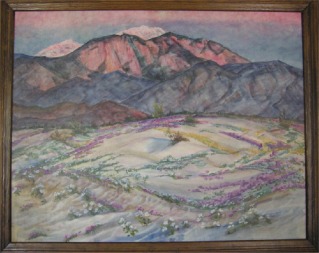
by Ted Schuyler. Painted in transparent Permasol oil. No year. Painted near Palm Desert, California Given to Tish by Lee Schuyler after Ted's death. Tish loved the pinks and purples. When Tish and Curt lived in Escondido, California, they would often pass this scenery going to and from Arizona. From the collection of Tish and Curt Gorman.
La Hacienda Mural
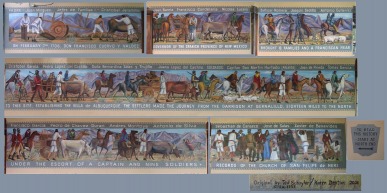
Ted Schuyler was always fascinated with the Hispanic and Indian culture of his native Southwest. During the early years of their marriage, the Schuylers lived in the “Casa de Armijo”, which occupies the east side of the Plaza in Old Town. In the 1930’s, the buildings of the “Patio Market” were really small apartments, which were occupied by various artists and writers. The larger building that fronted on the Plaza was the La Placita restaurant, and Ted often helped out with the cooking of the Mexican cuisine served there, although he was not a professional chef. The Schuylers were close friends with the Browns, who eventually became proprietors of that restaurant.
By the early 1950’s, the Browns lost the lease on the Casa de Armijo property, and moved half-a-block north to the current location. They also lost the name “La Placita”, so their restaurant was christened La Hacienda. Marie Brown commissioned Ted to do a fresco mural on the westward-facing external wall of this building, depicting the southward migration of twelve families from Bernalillo to Albuquerque in 1706. At least part of Ted’s remuneration for this work was in the form of complimentary dinners at La Hacienda, to which he often took out-of-town visitors.
This mural became something of an artistic landmark in Old Town, and over the years many people admired it. Unfortunately, due to the strong Southwestern sunshine, it began to fade. Ted left Albuquerque to live in Los Lunas with his daughter, later moving to Atlanta. Whenever one of Ted’s grandchildren or other relatives came to Albuquerque, they would make a point of stopping by Old Town to view grandpa’s work.
In 2008, La Hacienda underwent a major renovation, and the owners decided to restore the mural, hiring Karen Deaton of DreamScapes to accomplish this endeavor. Karen’s work is magnificently done, remaining totally true to the original composition but restoring the colors to remarkable brilliance. She has also made the attribution of Ted’s work very clear, which is excellent, since Ted had a penchant for “hiding” his signature and in recent years this had faded to almost complete illegibility.
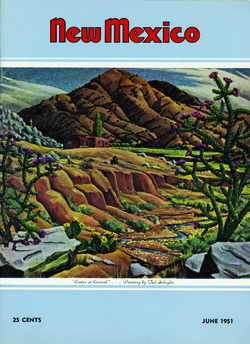
Baby Jo-Lee

by Ted Schuyler. Watercolor. Not dated, but circa summer of 1961. Ted nicknamed his first granddaughter Jo-Lee after both grandmothers and continued to call her that most of her life. Tish also had a baby doll in Michigan that she named baby Jo-Lee. This painting was probably done as a sketch. Tish asked Ted to sign it in the 1980's when she had it framed. From the collection of Tish and Curt Gorman.
Old Water Tower

by Ted Scnuyler. Watercolor, date not visible. Watercolor was unquestionably Ted's favorite medium, and there are literally hundreds of his paintings in the posession of family members, former students, and others. This is a typical choice of scene -- a ruined barn or dwelling, set somewhere in rural New Mexico. This particular painting is in the collection of his granddaughter Diana Guinn.
George Leslie Schafer, Jr.

By Ted Schuyler. This oil portrait of George Schafer dates from the 1939. George and Eloise Schafer were good friends of the Schuylers from pre-World War II, when they lived in Old Town Albuquerque. George had a little store that sold Indian goods in La Placita Restaurant. Submitted by George Schafer III.
Eloise Lucia Penoi Schafer

The companion piece to the portrait above, this oil portrait of Eloise dates much later, having been painted by Ted Schuyler in 1977, shortly after George's death in 1975. Its dimensions are 24 x 30. Her father was Laguna Pueble and her mother was Cherokee. One of her students at the Albuquerque Indian School made the Laguna dress for her in the 1930's, and the background is the juniper tree screen Ted often chose for formal portraits. On the back of the canvas is inscribed: Evergreen our friendship grows, & ever nicer, Eloise Love always, Ted
This painting is in the collection of Katie Schafer Harris.
Shadow Over the Valley
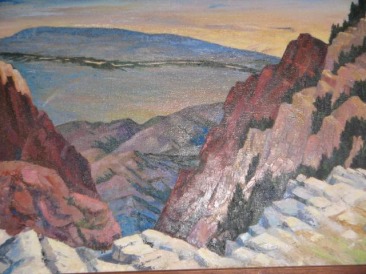
by Ted Schuyler. Oil, 24 x 30, dated 1967. The Sandia mountains, viewed both from the valley in Albuquerque, and from the crest, were always favorites of Ted's. This is looking towards the west from the crest at dawn, with the Rio Grande visible in the shadow of the mountains. This particular painting, and a very different one by Lee also featured on this website, are from a shared trip the artists made together, along with another artist friend. The date indicates that occurred after Trudie and her family had moved to Tuskegee, AL, From the collection of Tish and Curt Gorman
Crest View

by Ted Schuyler. Egg Tempera, 1943. Looking south from the area that is now the "antenna farm" on Sandia Crest, this early, stylized painting is one that Trudie remembers from childhood. From the collection of Lorna Barreras and Melvin Gorman.
Truchas
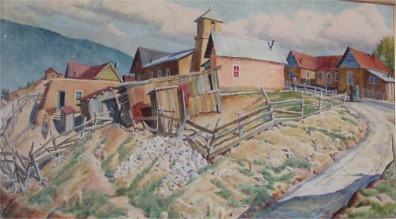
by Ted Schuyler. Painted in 1967 in permasol oil, the transparent oil medium which has many of the qualities of watercolor. This view of Truchas is a favorite of Ray, Trudie's husband, because his Dad had a special connection to that locale. This large panel is currently in the collection of the Chinle Gormans, but is also shared with the Rio Rancho couple.
Autumn Pastures


Two watercolor sketches by Ted were newly discovered by Terri Spiak at an estate auction in Albuquerque. They were included in a portfolio of unframed works. The water scene at the left, possibly from Las Huertas, one of Ted's favorite sketching spots, is dated 1966.
Terri doesn't know the connection between Ted and the original owners of these paintings, but is delighted with them and plans to frame them for display and enjoyment. Obviously, we think Ted would be delighted that they've found a new home. As mentioned, many of Ted's watercolor work was done during his teaching of classes, and he always gave a "demonstration painting" to a new student joining his class.

